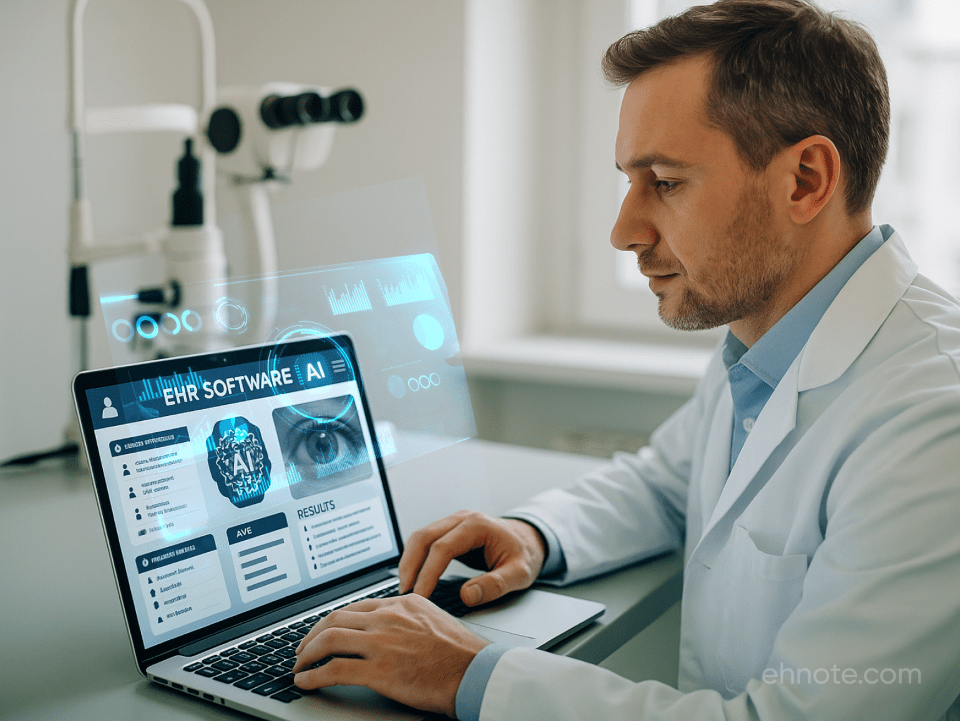Rewriting the Narrative: Why AI in Ophthalmology Complements, Not Competes

When DeepMind’s AI hit a 94.5% accuracy rate diagnosing retinal conditions—matching top ophthalmologists—it wasn’t just a tech flex. It was a glimpse into what’s possible when AI steps into your world, not as a rival, but as a trusted colleague.
Picture this: an assistant who gets your workflow, picks up on your clinical quirks, and respects your time constraints. That’s what AI in ophthalmology is starting to look like.
Your Wingman, Not Your Replacement
Let’s get one thing straight—AI isn’t here to take your place. Instead, think of it as a partner that amplifies what you already do so well. Those deep learning models crunching OCT scans, fundus photos, and slit-lamp images? They’re spotting diabetic retinopathy, AMD, glaucoma, and corneal issues with precision that rivals expert panels. But here’s the kicker: they’re designed to support you, not steal the show.
Take this example—a virtual assistant powered by machine learning classified eye disorders with over 95% accuracy, using real-time clinical data. It’s like having an extra set of hands during a packed clinic day, triaging patients and screening prelims so you can focus on the tough calls. Reassuring, right?
It’s not about handing over control; it’s about getting a little breathing room.
Faster, Smarter, and Still All You
Speed That Frees You Up
You’ve been there—staring at imaging data, wishing those minutes could go to a patient instead. AI changes that. It pulls critical insights in a snap, so you’re not buried in charts. Imagine finishing a diagnosis faster and having time to sit with that worried patient, explaining their options. That’s the kind of shift AI brings—more human connection, less grind.
Catching What Hides
What if you could spot trouble before it’s obvious? AI’s got a knack for picking up subtle signs—like tiny vascular changes in diabetic retinopathy or early optic disc shifts in glaucoma—that might slip past even the sharpest eyes on a long day.
Studies from PMC, arXiv, and Simbo AI back this up: AI sees patterns over time, giving you a head start to save vision. It’s like a safety net you didn’t know you needed.
Consistency You Can Trust
Ever worry about missing something when you’re exhausted?
AI doesn’t. It applies the same sharp standards to every patient—same thresholds, same signatures. That cuts down on variability and those little errors tied to fatigue or bias, as PMC and Wikipedia point out. Think of it as a steady second opinion, always ready when you need it.
An Assistant That Gets You
Picture this: an AI that learns your style. It suggests diagnoses based on imaging and history, auto-fills follow-ups, patient handouts, even referral letters. Oh, and it flags any chart gaps before you hit save.
This isn’t sci-fi—it’s ambient charting in action, built to match how you think and work. DeepCura AI, Review of Ophthalmology, and Simbo AI studies show it saves time without losing that personal touch.
Reassuringly, it’s like a colleague who’s always one step ahead—but never in your way.
Less Paperwork, More Patients
AI doesn’t stop at the clinic door—it tackles the admin mess too:
- Smart Billing:It scrubs claims using EHR data, catching errors before they bounce back, per Wikipedia and WIRED. Less rework, more peace of mind.
- Virtual Helpers: These tools handle messaging, appointments, reminders—even triage—automating up to 85% of that back-and-forth, according to industry insights. Your staff gets to focus on what matters, not drown in routine.
You’ve built an amazing practice. AI’s here to lighten the load, not add to it.
Proof It Works—In the Real World
In the UK, DeepMind’s algorithm tackled nearly 1,000 OCT scans, matching top retina specialists across 50+ conditions, as reported by Financial Times and WIRED.
Another model hit 95% accuracy classifying disorders with over 60 features, standing toe-to-toe with experts (PMC). This isn’t just lab talk—AI’s cutting costs, speeding workflows, and bringing solid screening to underserved clinics where specialists are scarce, per ScienceDirect and Nature. It’s practical, and it’s making a difference.
Built for Your Day, Not a Research Lab
Why does AI fit so well in ophthalmology?
- Image Goldmine: Your field churns out OCTs, fundus shots, and topography—perfect fuel for machine learning, says JMAJ.
- EHR Harmony: It pulls data, suggests steps, and slots right into your workflow—no clunky add-ons.
- Trustworthy Clues: Some models highlight what they see—like optic cup ratios—so you can follow their logic, per industry reports and PMC.
It’s tech that bends to your routine, not the other way around.
What You Need, Delivered
You want tools that:
- Fit your flow, not fight it.
- Show their work, so you’re never guessing.
- Slide into your workflow like they belong there.
- Learn your habits and get better with time.
AI’s stepping up to that challenge.
A Future That’s Still Human
AI isn’t here to edge you out—it’s here to lift you up. Imagine software that knows your next move—handling triage, coding, compliance—so you’re left with less chaos and more clarity.
Fewer clicks, faster calls, steady diagnoses, smoother billing. It’s about making your day work better, not harder.
Beyond Assist—Toward Understanding
AI’s growing into something more—think real-time progression alerts, no-show predictions, or tailored patient messages.
The point? Cut your cognitive load so you can focus on care, not clutter. It’s not replacing your empathy—it’s giving you room to use it.
Ready to see how AI could slip into your practice? Let’s chat about it—because your patients deserve the best, and frankly, so do you.
Get in touch with us to learn more about what the future of ophthalmic technology holds in for you and how you can make use of the right technology to gain an edge with minimal efforts!
Learn More About EHNOTE’s Ophthalmology EHR Software